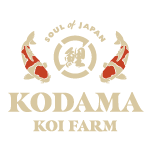Kansuke Koi Farm
His Kohaku has won a grand champion in All Japan Nishikigoi Show. The title proves the excellence of his Kohaku. All the Koi hobbyists who want to win championships are eager to get Kohaku from Kansuke.
Learn More About Kansuke Koi Farm
Owner(s): Seiji Tomono
Founded: 1972
Specialty: Kohaku
Description: His Kohaku has won a grand champion in All Japan Nishikigoi Show. The title proves the excellence of his Kohaku. In Ojiya City of Niigata, Kansuke Koi Farm is founded by Mr. Seiji Tomono in 1972. Among Koi which Kansuke breeds, Kohaku is the most famous variety. The hi (red) quality of Kansuke Kohaku is superior to that of all other bloodline Koi. Growing big is another characteristic of this bloodline. The pattern and quality of Koi are very important in Koi. But large body conformation is more important because if the body is more than 80 cm (32 in.), it has more chances to win grand champion titles. Kohaku of Kansuke have the quality of big growth. All the Koi hobbyists who want to win championships are eager to get Kohaku from Kansuke. His famous Kohaku Nickname: Scarlet Grand champion of the 30th ZNA All Japan Nishikigoi Show.
Interview with Kansuke Koi Farm
Interview on July/August 2004
Kansuke Koi Farm –Part 1
by Mamoru Kodama
When asked, “What is the highest graded koi in Japan?,” the answer is koi from the breeder whose koi won, Grand Champion at All Japan Nishikigoi Show. Look at picture 1. At a glance, everybody can understand that the koi expresses the highest quality of Kohaku with its pure white skin, deep red hi and lively body conformation. The breeder of this Kohaku is Mr. Seiji Tomono at Kansuke Koi Farm. I interviewed him this time.
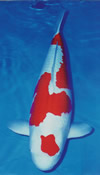
*pic1
Kodama:
Breeding the Grand Champion koi at the All Japan Nishikigoi Show proves that you are one of the top breeders in Japan. What policy do you have as a top breeder?
Tomono:
It is a difficult question, but I think it really is “how clear your goal is” and “how much you are dedicated to the goal.”
Kodama:
I see.
Tomono:
Each breeder has its own goal. For example, some breeders may want to breed small but beautiful koi. Others may try to breed large koi. There are as many goals as breeders. The question is how strong you want to realize the goal and how much you can devote yourself into it. In my case, I wanted to win Grand Champion at the All Japan Nishikigoi Show. And I have always thought what I should do to win and what kind of koi I should breed.
Kodama:
Grand Champion at the All Japan Nishikigoi Show equals top breeder in Japan. Your policy is “to keep strong desire to win the grand champion.”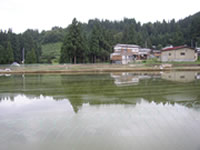
Tomono:
Yes, it is very difficult, but absolutely true.
Kodama:
Now let us know about the root of “Kansuke Kohaku.”When was your company founded?
Tomono:
My mother actually started the business. And I took over the business.
Kodama:
So your mother start this?! Then, may I ask you a few questions? Please introduce me to her.
Tomono:
She is now 84 years old. Her name is Kiku.
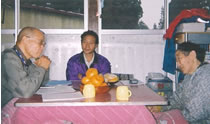
Mother of Mr. Tomono She shares her story with Kodama
Kiku:
Because my parents bred koi, I liked koi very much since my childhood. My husband, who is Seiji’s father, was a local official. So he did not breed koi. But we were also a rice farmer. So I released and raised koi in the rice fields.
Kodama:
Did you breed the fry?
Kiku:
No, I was not able to breed them. I bought fry from my father or Hoshikin Koi Farm nearby and released them.
Kodama:
Do you remember how long ago that was?
Kiku:
It is about 50 years ago.
Kodama:
How much were they at the time?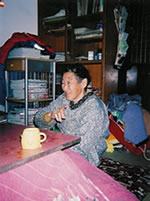
Kiku:
I usually had a budget of 10,000 Yen. I got what my parents bred, so I am not sure exactly how much. When they had a good crop, they gave me 2000 or even 3000 fry. I released them to the rice fields around June.
Kodama:
Did you harvest them in autumn?
Kiku:
Yes. When we harvested rice, we pulled koi at the same time. That was the most exciting moment.
Kodama:
How many did you harvest by autumn?
Kiku:
I was able to take at least 300 every year.
Kodama:
Did you sell them?
Kiku:
No. Because I am a woman, I did not sell them. Because I liked them, I kept them. I released those koi to a mud pond about 3550 square feet wide and raised them to 2 years old.
Kodama:
Because you liked them, you raised them.
Kiku:
Yes. Because I was a woman and also because my husband had a salary, I did not have to sell them. I was able to raise koi simply for my pleasure. I cannot describe how exciting it was to catch koi at the time of rice harvest. And my son took over what I like as his business. This is a very pleasant thing.
Kodama:
So did you help your mother since your childhood?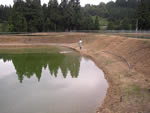
Tomono:
Yes, I did. Since I was a kid, I was with her and chased after koi in the rice fields. Because there was no entertainment like TV nor Nintendo, helping her was my daily task. Catching koi was one of my favorite events. I remember I helped her very much.
Kodama:
When did you start thinking about making your mother’s favorite koi activity as your business?
Tomono:
It was 1965.
Kodama:
Is the variety Kohaku?
Tomono:
Yes. This Shiodani area has many breeders such as Hoshikin Koi Farm and Seki Carp. Their breeding variety was also Kohaku. So I began with Kohaku, too.
Kodama:
Is that Kohaku the origin of the present “Kansuke Kohaku”?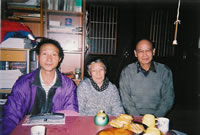
Tomono:
Actually, not. It was Showa that made me realize the true attractiveness of breeding koi. It was about 5 to 6 years after I took over koi breeding from my mother. In 1970, I got a pair of Showa. It was the famous Showa brand “Kobayashi Showa” at the time. The pair produced very nice koi. At the autumn harvest, I sold those for very good prices. Then, I realized koi business can actually bring a good profit. Since then, I became more serious about koi breeding.
Kodama:
The Shiodani area is the mecca of Kohaku. Showa in this area sounds interesting.
Tomono:
I agree. Shiodani area is famous for Kohaku. And breeders here produce only Kohaku. So buyers who come here have come for Kohaku from the beginning. But nobody wants to spend good money for Kohaku that a novice breeder produces. That is why I bred Showa.
Kodama:
You bred what nobody bred in this area. That is very smart.
Tomono:
Luckily, my Showa turned out beautiful. Buyers who did not even care about me started buying koi from me. I thought the koi business was very interesting.
Kodama:
Did you continue to breed Showa?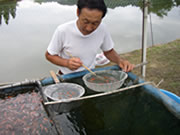
Tomono:
No. Because I still believed that Kohaku was the best variety for the clay quality in this area, I bred Showa only for 2 years and then switched to Kohaku again.
Kodama:
Did those buyers purchase your Kohaku at the time?
Tomono:
Yes. After all, what counts is determination. My Kohaku before I bred Showa was a lower quality than others. No buyer would buy a lower-quality koi. Being in this Shiodani area, I was very determined to breed “high quality Kohaku that beats others.” That helped me to breed high quality Kohaku and buyers started to buy Kohaku from me. In this sense, 1970 was a turning point. Showa gave me the right mental attitude as a koi breeder.
Kodama:
Tell us in more details.
Tomono:
As long as you are a koi breeder, you must have a “right mental attitude as a koi breeder.” I set my firm goal to breed “higher quality Kohaku than anybody else” in this very competitive Shiodani area. From the moment I set that goal, I was able to breed Kohaku that buyers can buy.
Kodama:
I see that strong determination.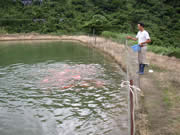
Tomono:
The experience with Showa taught me that koi must be better in “uniqueness,” “beauty” and “size.” To achieve it, you truly devote yourself. At first, I bred Showa that nobody bred in Shiodani in order to attract buyers. Then, I decided to breed the best Kohaku in Shiodani. Then I decided to breed the best in Japan, which is Grand Champion at All Japan Nishikigoi Show.
Kodama:
I see. That is how you finally bred the grand champion with Kohaku on the picture.
…To Be Continued
Interview Part 2 with Kansuke Koi Farm
Interview on September/October 2004
Kansuke Koi Farm –Part 2
by Mamoru Kodama
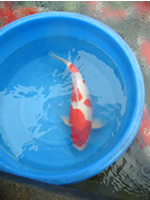
Kansuke Kohaku grew 28 in 3 years. Most of his Koi are sold at the age of 2. The 2 year-old Koi are relatively thin. But they will gain such distinguished body conformation with their growth. Mr. Tomono hopes that hobbyists who obtained his Koi challenges this body conformation.
From June through August, it is the season of culling koi in Niigata. In the entire Niigata, you will see more than 1000 people involved with “culling fry.” Koi dealers in Japan pay attention to culling fry because they could become a future Grand Champion. I would like to continue the interview with the breeder, Mr. Seiji Tomono.
Kodama:
Every breeder seriously breeds koi and believes in his koi. When did you start having confidence in your koi?
Tomono:
I think that is when I won champion. After winning the championship, I realized that “koi at this level” is the koi at the grand champion level. No matter how hard I studied the grand champion koi bred by others at the All Japan Nishikigoi Show, I could not really understand the level of Japan’s best koi until I won with my own koi. That is the time I finally got confident in my own koi breeding.
Kodama:
I see. Please tell us how you breed champion koi.
Tomono:
As you know, this area called Shiodani is famous for Kohaku. Beautiful Kohaku have been bred here for a long time. But when I studied, no Japanese grand champion had been bred at all from here, not even once. So I studied why and noticed that most of the grand champion koi are more than 85 cm (34?). Koi in the Shiodani area become beautiful but do not grow big. I finally noticed that this is the fatal point, and my challenge to breed a large koi started.
Kodama:
Interesting.
Tomono: It took me 10 years to win the grand champion since I came to that discovery. I have done various things to breed champion koi. What I learned from this process is that “I must always have the goal in mind and focus on achieving it.”

*pic1
Kodama:
What did you do exactly for 10 years to achieve the goal?
Tomono:
I studied about breeders who were winning champions. At the time, Dainichi Koi Farm bred large koi and was Japan’s best koi breeder. So I went to his place every day and studied how to breed large koi.
Kodama:
Then, what did you notice?
Tomono:
DNA. I thought I must introduce the bloodline of big growth into Shiodani.
Kodama:
I see. But, I do not think Dainichi has been the best only for its size.
Tomono:
I agree. It is not just the size. His koi have thick beni. Koi from Dainichi thickens its hi plate as it grows. Therefore, hi does not disappear in the process of growth. Hi could fade and disappear if a koi grows too fast. I developed my koi for “the large size” and “the thick beni.”
Kodama:
How did you develop your koi?
Tomono:
Developing koi is all about finding the match of parents. So I began with looking for parents.
Kodama:
You must have had a difficult time to find parents.
Tomono:
To be honest, it is not that difficult because I can find them at koi shows.
Kodama:
I see. At the All Japan Nishikigoi Show, all the excellent koi come to enter from all over Japan. That is the best place to look for parents. But do owners sell to you willingly?
Tomono:
It is not that difficult when I explain and sincerely ask that I want to use his koi as a parent. I think owners also feel happy to be a part of establishing a bloodline.
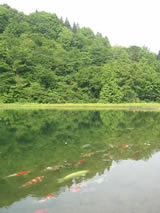
Ponds that keep hobbyists' Koi in Niigata Many hobbyists in Japan leaves Koi to excellent breeders in order to win grand champions. They keep 20-30 Koi in 0.5-2 Acres ponds. It usually costs $300-$1000 for one season, sometimes $2000 for a special Koi.
Kodama:
We should appreciate koi hobbyists’ understanding on the breeding. What is going to happen next?
Tomono:
In the old days, we crossed two to three males to one female. So even though I found a good match, I could not confirm the male parent. Now, because of artificial insemination, I can specify the pair. I think this is an epoch-making method in koi development. I use this method all the time.
Kodama:
How many parents do you have now?
Tomono:
I have many parent candidates. The main ones are seven pairs.
Kodama:
Do you change the combination of the pair every year?
Tomono:
Once I find a good match, I do not change. Because it is a living creature, accidents can occur. Male or female parents have died right before the spawning. At the time, the idea of which replacement to use flashes in my mind. So I ALWAYS think about the possible combination. If I do not do this, I cannot make the best pairing when necessary. This is very important.
Kodama:
I agree. Excellent koi all originated from the combination of the parents.
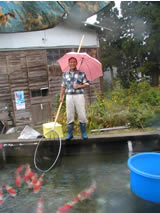
In October, Koi are pulled out of mud ponds and displayed in about 10t (2500 gal.) ponds for buyers. Mr. Tomono is happy with the harvest.
Tomono:
One more important factor goes to making a champion koi. It is fact that a koi hobbyist eventually raises the koi. If the hobbyist does not have a good pond and good raising skills, a potential grand champion koi cannot become a champion. I breed koi with excellent bloodline parents that have produced grand champions. I raise them to two to three years old (35–60 cm: 14–24?) and sell them. A grand champion requires the size of 85 cm (34?). So customers need to raise the koi from 35–85 cm. The 50 cm (20?) is up to the customers. If they cannot raise the koi, any koi even with the greatest potential, cannot become the grand champion. This is where the dilemma lies.
Kodama:
I see. Not many customers have ideal ponds to raise grand champion koi. And many of them are too busy to take care of the koi. This is why in Niigata many ponds keep koi for customers. I think Dainichi Koi Farm which produced many champion koi, had many ponds to keep customers’ koi.
Tomono:
It is true that the chances are low when koi hobbyists raise koi. But our job is to make “koi that hobbyists can enjoy.” Raising champions is a thrilling challenge. I believe it is the best pleasure that we can get in this hobby. I would like hobbyists to enjoy this best pleasure themselves.
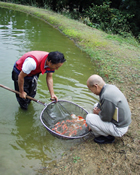
Kodama examines excellent selections of Koi that went through 4 strict culling of Mr. Tomono.
Kodama:
In Japan, excellent koi are raised in dealers’ pond. My company has many ponds. I have them to provide this service to raise champion koi for my customers.
Tomono:
The growing skills of your staff are at the highest level in Japan. Many of my koi have grown at your place for koi shows. This is how your staff helps hobbyists; however, I do not think this is how it should be. After all, koi are for hobbyists to enjoy and for them to raise by themselves.
Kodama:
Because of housing conditions, not many people can afford large ponds in Japan. They cannot have ponds to raise grand champions even though they would love to. This is why they leave koi to me. Hobbyists in the United States have a lot better environment than the Japanese. If they want to, they can build a large pond.
Tomono:
That sounds wonderful. If you have a good facility and provide proper care, my koi will grow to be beautiful like the one on the picture. I have absolute confidence and promise that they would become grand champions.
Kodama:
It is such a promise, isn’t it?
Tomono:
All excellent koi begins with believing in koi.
Kodama:
Thank you very much for sharing your valuable experience and thoughts.
We have koi available to buy from Kansuke Koi Farm online if shown below the search field. If not, contact us with what you're looking for and we'll help find the right koi.
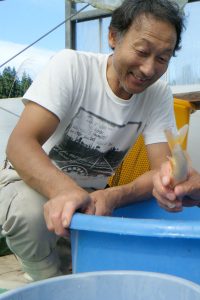
We couldn't find any products in our online store for your search in our Kansuke Koi Farm catalog,
BUT we may have inventory at the farm or in Japan, so please use the "Request a Koi" form to help us find your perfect koi fish.
Koi Auctions Ending Soon!
Place your bids now to win your choice of beautiful Japanese koi for sale at a great price! We always have a variety of fixed price koi and consistently run koi auctions ending daily; with most special auctions ending on Wednesday and Sunday each week.
-

Kohaku – koi #x0121n007
Starting bid: $300.00 Time leftEstimated Value: $1,800.00Breeder(s): Dainichi Koi FarmSex: UnknownBorn in: 2024Size: 9.00 inch / 23 cmVariety: Kohaku, -

Showa – koi #x0121n018
Starting bid: $300.00 Time leftEstimated Value: $1,800.00Breeder(s): Dainichi Koi FarmSex: UnknownBorn in: 2024Size: 8.00 inch / 21 cmVariety: Showa, -

Showa – koi #x0121n020
Current bid: $300.00 Time leftHighest Bidder:marcelo PequenoEstimated Value: $1,800.00Breeder(s): Dainichi Koi FarmSex: UnknownBorn in: 2024Size: 7.00 inch / 20 cmVariety: Showa,
Kohaku – koi #x0121n019
Starting bid: $300.00 Time leftEstimated Value: $1,800.00Breeder(s): Dainichi Koi FarmSex: UnknownBorn in: 2024Size: 8.00 inch / 21 cmVariety: Kohaku,
